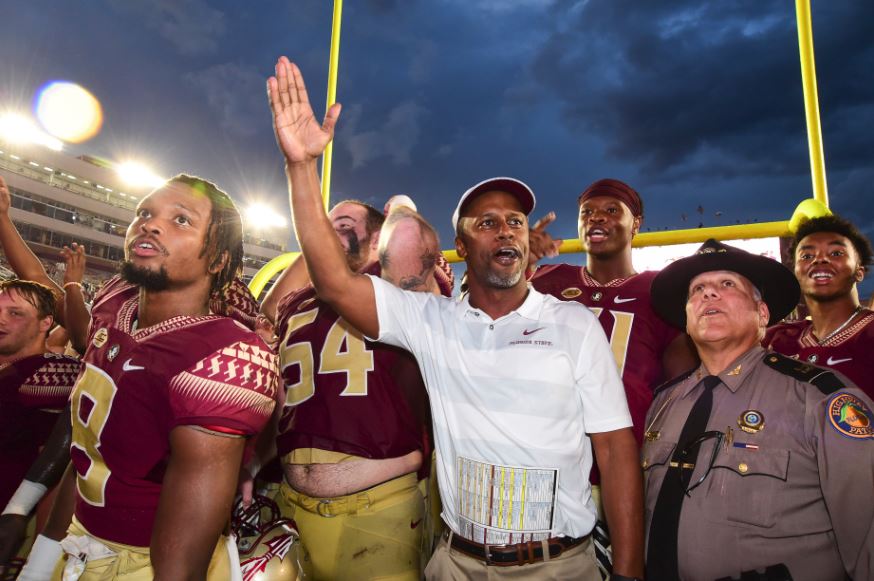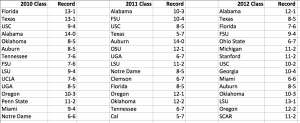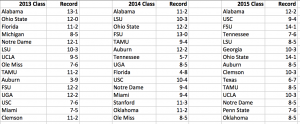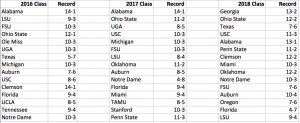- Sunday Seminole Summary: FSU Football Adds Pair of WR Transfers
- Sunday Seminole Summary: FSU Football Exits ESD With Top-15 Class
- Sunday Seminole Summary: FSU Soccer Tops BYU for Third National Championship
- Sunday Seminole Summary: FSU Soccer Advances to National Championship Match
- Seminole Sunday Summary: FSU Soccer Heads Back to College Cup
- Seminole Sunday Summary: FSU Soccer Reaches Sweet 16; Football Tops Boston College
- Seminole Sunday Summary: FSU Soccer Wins ACC, Advances to Second Round of NCAA Tournament; FSU Football Rallies Past Miami
- Seminole Sunday Summary: FSU Soccer Tops Wake on OT to Advance to ACC Final
- Seminole Sunday Summary: FSU Football Crushes UMass for Third Straight Win
- Seminole Sunday Summary: FSU Soccer Stays Perfect with Pair of Wins
FSU Recruiting: What is the Minimum Record Needed for a Good Class?
- By Clint Eiland
- Updated: November 29, 2018
 Jeff Romance/FSU Athletics
Jeff Romance/FSU AthleticsThe Florida State Seminoles stumbled to a very disappointing 5-7 record in 2018, leaving them without a bowl for the first time in over three decades. Understandably, this has fans worried about the program, and not just on the field.
One of the draws of Willie Taggart was his prowess as a recruiter. He raised the talent level at Western Kentucky, restocked South Florida, helped Oregon break through, and is now expected to maintain elite classes at Florida State.
Everything is ripe for his taking. He is in his home state, with a staff known for recruiting, at one of the premier programs in college football. But the 5-7 season has put that slightly in jeopardy, even if he closed spectacularly well in the 2018 class.
In general, the record for a first-year head coach tends to not matter all that much to recruits. Since the team he takes over is not his players and not his system, any competent staff will not base a pitch on the first-year results. Instead, they point to what their vision is and how that recruit fits into it. For Florida State, this includes an overhaul of the offensive line and early playing time at various positions.
Yet, there still needs to be a baseline for a good recruiting class. A vision of the future is fine up to a certain extent, but even the most confident of recruits wants to see reasons for optimism. Truly awful records like 0-12, 1-11, and 2-10 do not bring in much talent.
The Seminoles had momentum all throughout the offseason, gaining the commitments of 12 blue-chip prospects from January 2018 to right before the first game of the season. Expectedly, it slowed down as the regular season went on. Now, fans are beginning to wonder if the 2019 class will be a bust.
At one point, Florida State was considered the clear leader for top-5 prospect Kayvon Thibodeaux, and was working towards flipping highly-ranked players like George Pickens and Trezmen Marshall. All three are considered long shots at the moment. Is Florida State’s record holding it back?
We became interested in the question of what it would take for the Seminoles to keep a quality recruiting class. To try and answer that, we looked at the recruiting class rankings from 2010-18 and the team records that preceded those records.
For this examination, we used the top-15 class rankings from 247Sports. Keep in mind that the recruiting industry started to normalize around the mid-2000s and did not have totally consistent rankings until 2011 or so. While there remain differences between the main services of Rivals, ESPN, and 247Sports, players and classes tend to hover around the same spot, although it did not totally hit its stride until 2012 or so.
Another note: The classes are for the season that the eligible recruits can play in. That means that the record listed is the season prior. So if one wanted to know why Florida finished with the No. 1 class in 2010, it was linked to the 2009 season, which is what the commits of that class witnessed before signing.
Here are the results. We split them into three segments, 2010-12, 2013-15, and 2016-18.



Results
Since the 2010 class, there have been seven classes in the top 15 by teams who won less than six games. They ranked fourth, 15th, 10th, seventh, ninth, seventh, and 14th. Only one of those was the first full class for a first-year head coach: 2014 Tennessee.
The worst record to ever finish in the top 15 was Auburn’s 2013 group that landed at No. 10 overall after a 3-9 season. Part of that was Gus Malzahn getting hired in the offseason and doing a fantastic job of salvaging the class.
Florida State currently ranks 14th in the nation, according to the 247Sports Composite. The class recently dropped after 4-star tackle Charles Cross decommitted, and the staff does not expect him to rejoin. But the Seminoles are only at 15 commits and will look to sign at least 20.
There is considerable room for growth, and in the next few weeks there will be multiple blue-chip players announcing their school choices. Florida State is considered the clear favorite for one (Raymond Woodie III) and the slight leader for another (Will Putnam). We will have more on those later.
We played around with the 247Sports class calculator to see where FSU might rank if it closes on a couple of its targets and takes some JUCO options. It confirms what the data above tells us: The Seminoles will almost certainly be in the top 15 and come very close to the top 10.
However, it would be very surprising to see them finish any higher than 10th. Recruiting classes have become more concentrated towards the top since 2010, so the separation between the elite and the “very good” is larger.
As for our personal opinion?
We think that the 5-7 record lowered the ceiling for the class. But it did not move the floor all that much. There were certainly bad moments all throughout the season, yet the Seminoles still did have a thrilling victory over a top-20 Boston College team and put together encouraging performances against MAC West champion Northern Illinois and bowl-eligible Wake Forest.
That should be expected, though consider the perception if they struggled with those teams like they did with Samford and Louisville. At 5-7, the staff can also add in a pitch that all they needed was better players to push them over the edge.
This is where the staff will earn their paycheck. Even if the actual season did not go as planned, the staff needs to be able to sell their recruiting pitch. A big part of the disappointment was the fact that talent was concentrated in certain spots and deprived in others.
FSU needs that influx of talent in the latter if Taggart wants to be here after 2020. The 5-7 record is a negative any way you slice it — but it is not a fatal wound.

You must be logged in to post a comment Login